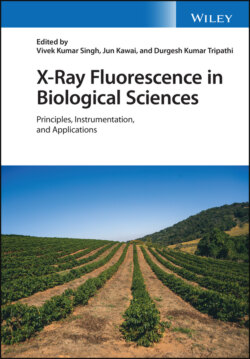Читать книгу X-Ray Fluorescence in Biological Sciences - Группа авторов - Страница 63
4.5 Suitability of TXRF for Elemental Analysis in Biological Samples
ОглавлениеBiological samples, e.g. blood, serum, urine, plasma, tissues, etc. contain more than 80% water and the residues left behind by the removal of water have mainly low Z elements like C, H, N, O, etc. and hence do not pose the risk of appreciable matrix effects. These samples can be analyzed by TXRF for trace elements using simple sample processing and mixing with a suitable internal standard. Other biological samples, e.g. dental plaque, hair, nails, bones, etc. can be analyzed either directly with a very small amount of sample giving no appreciable matrix effect, or after sample processing. As stated in the beginning of this chapter, the trace elements present in biological samples play an essential role in human health and their concentration level may be an indicator of good health or disease involved or a risk of certain diseases. The role of trace elements in biological progress in animals and plants has been investigated in detail and reported in several literatures. Some of the elements may enter into the biological system due to pollution or the working/living atmosphere of the human being. Also the determination of concentration of certain metals in parts of the body acts as a bio‐marker or indictor of some serious disease or disorder. Moreover, during treatment of cancer some carrier elements of medicines, e.g. platinum, may enter into the body system and their presence must be assessed in order to study the action mechanism of platinum‐containing drugs in the body. For these reasons, the determination of the trace elements in biological systems is very important. The techniques which can normally be used for such determinations are ICP‐MS, ICP‐OES, atomic absorption spectrometry with either flame (FAAS) or electro thermal atomization (ETAAS), etc. In order to avoid severe interferences, these techniques generally require the digestion of the sample and matrix separation. In addition, the matrix removal makes the solution used for analysis less viscous and free flowing during atomization for ICP‐OES and ICP‐MS analysis. Further, the sample requirement for ICP‐OES and ICP‐MS is a few ml of solution, which requires at least a few mg of biological sample. These samples can also be analyzed by TXRF with almost similar detection limits as by other techniques. However, TXRF has some advantages over these techniques, e.g. the sample requirement in TXRF is very small, all metals and non‐metals, from C to U, can be analyzed with different detection limits and a simple quantification procedure [11]. As stated above, the matrix removal is necessary in TXRF analysis also ‐ not for avoiding interference but to make TXRF conditions feasible and reduce background. Since matrix elements present in biological samples are mostly low Z elements, the matrix shall not pose an appreciable absorption enhancement effect, but rather scatter the X‐rays intensively leading to increased background or poor detection limits. After some modifications in sample preparation, it is possible that these samples can be directly analyzed by TXRF. Thus, due to these advantageous features, such as a sample requirement of microgram or lesser quantities, the possibility of multi‐element analysis from C to U alike for metals and nonmetals, direct elemental analysis, as well as simple quantification, TXRF analysis is well suited for biological samples.
In addition to trace element determinations, the oxidation state determination of the elements present in a biological system, or elemental speciation is also very important. Only a few techniques are available for speciation studies, especially at trace levels of elemental concentration and using very small amounts of sample. TXRF based X‐ray absorption near edge spectroscopy (TXRF‐XANES) can be used for such studies. However, such studies can be performed using Synchrotron light sources. For such applications, the X‐ray beams of variable energies, covering the absorption edge of the element being studied, are allowed to fall on the sample at an angle less than the critical angle and the TXRF spectra are measured for each energy for a short duration by varying the excitation energy in steps. The TXRF emission spectra are converted to XANES spectra and the oxidation state of the analyte element is determined using a similar spectra of standards. This kind of study is very useful and can be done using Synchrotron light sources, but is not possible with conventional lab based TXRF spectrometers, especially at such trace levels and with very small amounts of sample [8].
The attractive features of TXRF for biological samples can be summarized as given below:
1 Requirement of very small sample amounts e.g. a few microlitres or micrograms.
2 Non‐destruction / non consumption of the sample during analysis.
3 Multi‐elemental determinations of metals and nonmetals alike in the same sample.
4 Detection limits comparable to other trace element determination techniques, e.g. ICP‐OES and ICP MS.
5 Simple quantification and sample preparation.
6 Possibility of direct sample analysis.
7 Elemental Speciation in TXRF‐XANES mode.
